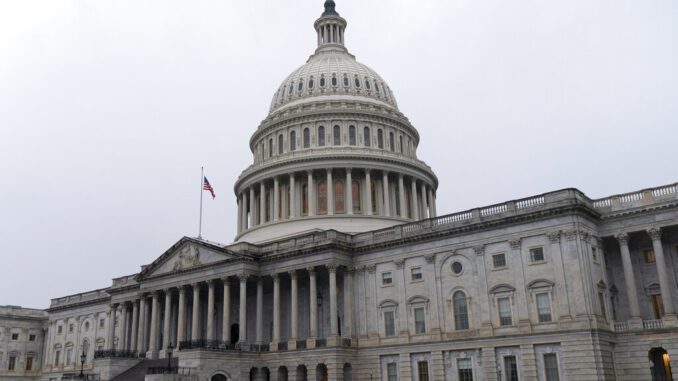
There are gimmicks, and then there are gimmicks. Some are relatively harmless and can be helpful when they grease enactment of bills with positive effects that outweigh them. There are others, however, that are so egregious and damaging that they are beyond redemption.
Such is the case with a tax and Medicare maneuver championed by the Biden administration. It would double-count trillions of dollars by using the same source of revenue both to pay for the social welfare spending bill now being assembled in Congress and to forestall the coming insolvency of the Medicare Hospital Insurance (HI) trust fund. (Last year, Medicare’s trustees projected HI would be depleted of reserves in 2026.) The result would be more federal borrowing, and a higher debt burden for future taxpayers.
The gimmick in question has a tangled backstory:
The Affordable Care Act (ACA) created the net investment income tax (NIIT) to secure additional revenue from high-income taxpayers. Individuals with incomes exceeding $200,000 annually (and couples with incomes in excess of $250,000) began in 2013 to pay a 3.8% tax on their non-wage sources of income, such as rent, dividends and royalties. The NIIT’s income thresholds are not indexed; consequently, increasing numbers of Americans are paying this tax as nominal income growth pushes them into the “high income” range.
The ACA also added a 0.9 percentage point increase to the HI payroll tax rate for workers with total incomes exceeding the same thresholds applicable for the NIIT. The add-on brings the total HI tax rate for these individuals to 3.8% (the base rate is 2.9%, split evenly between employers and employees; the add-on applies only to workers). The NIIT and HI tax changes were designed to ensure parallel treatment of wage and non-wage income for upper-income taxpayers.
At the time of the ACA’s enactment, the Joint Tax Committee estimated the combined additional revenue from these provisions at $210.2 billion over the law’s first decade (2010 to 2019). JCT now estimates the NIIT alone will generate $27.5 billion in federal revenue in 2021.
The NIIT and the HI payroll tax add-on were central to securing passage of the ACA because they allowed the authors to argue the law would reduce, not increase, projected federal budget deficits. In 2010, the Congressional Budget Office (CBO) estimated the ACA would reduce the deficit by $143 billion from 2010 to 2019, and by up to 0.25% of GDP over the following decade.
The revenue attributable to the 0.9% HI tax add-on was double-counted. It was included in the claimed $143 billion of deficit reduction from the full ACA, and it was deposited into the HI trust fund to forestall insolvency.
This double-counting was not precluded by budget rules because CBO’s baseline convention is to assume full HI spending into the future even when the trust fund is expected to run out of reserves. Thus, when Congress replenishes HI, there is no resulting increase in HI spending to cancel out the budgetary effect of the added source of funds.
The ACA’s architects wanted the NIIT to be deposited into the HI trust fund too, but they were blocked by procedural hurdles in Congress.
In its budget, the Biden administration has proposed to increase revenue from the NIIT and from the HI payroll tax by tightening definitional rules for pass-through businesses owned by Americans with annual incomes exceeding $400,000. The Treasury Department estimates the changes would produce $236.5 billion in revenue over the period 2022 to 2031.
The administration also wants to send these tax receipts to the HI trust fund. Further, it wants the NIIT revenue collected under current law to be redirected from the general fund of the Treasury to the HI trust fund too.
The sums involved are staggering. According to the Committee for a Responsible Federal Budget (CRFB), the NIIT and HI tax changes in the Biden plan would generate about $1.2 trillion in new revenue over 30 years. The diversion of current law NIIT revenue to HI would add $2.2 trillion to the trust fund. Again, this is revenue that was central to CBO’s assessment showing the ACA would reduce the government’s long-term deficits. In total, the administration wants to double count $3.4 trillion. CRFB estimates this would be enough to push back HI insolvency by 14 years, from 2026 to 2040.
That would not be the only consequence of this maneuver. Future taxpayers would be forced to service an additional $3.4 trillion in federal debt because one source of revenue was used to pay for two streams of spending.
Advocates will claim no rules are broken by double booking the proceeds from these taxes, and that is true. But just because the rules do not preclude the maneuver does not mean it is harmless, or advisable.
Medicare needs reform, not a bailout that disguises the burden it is passing onto taxpayers. If Congress wants to expand social welfare programs, it should do so without exacerbating the nation’s already daunting long-term budget challenge.
James C. Capretta holds the Milton Friedman Chair at the American Enterprise Institute. This article was first published in RealClearPolicy.



